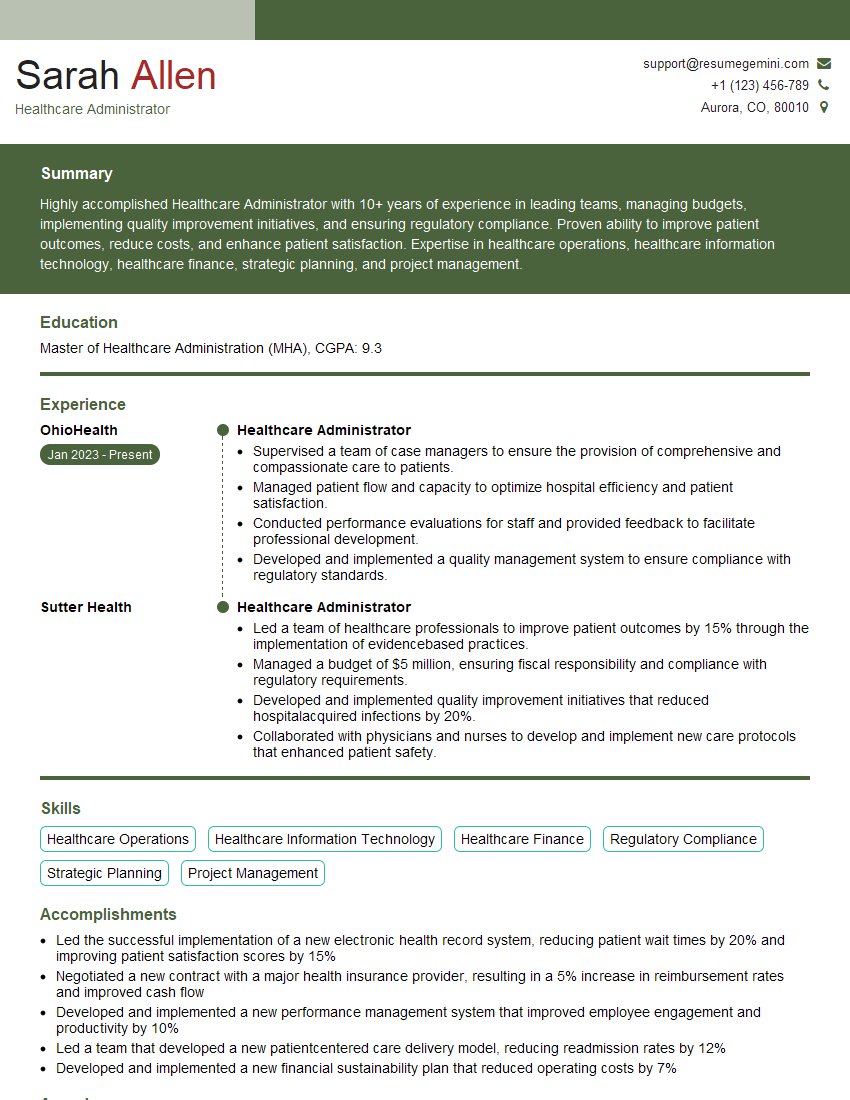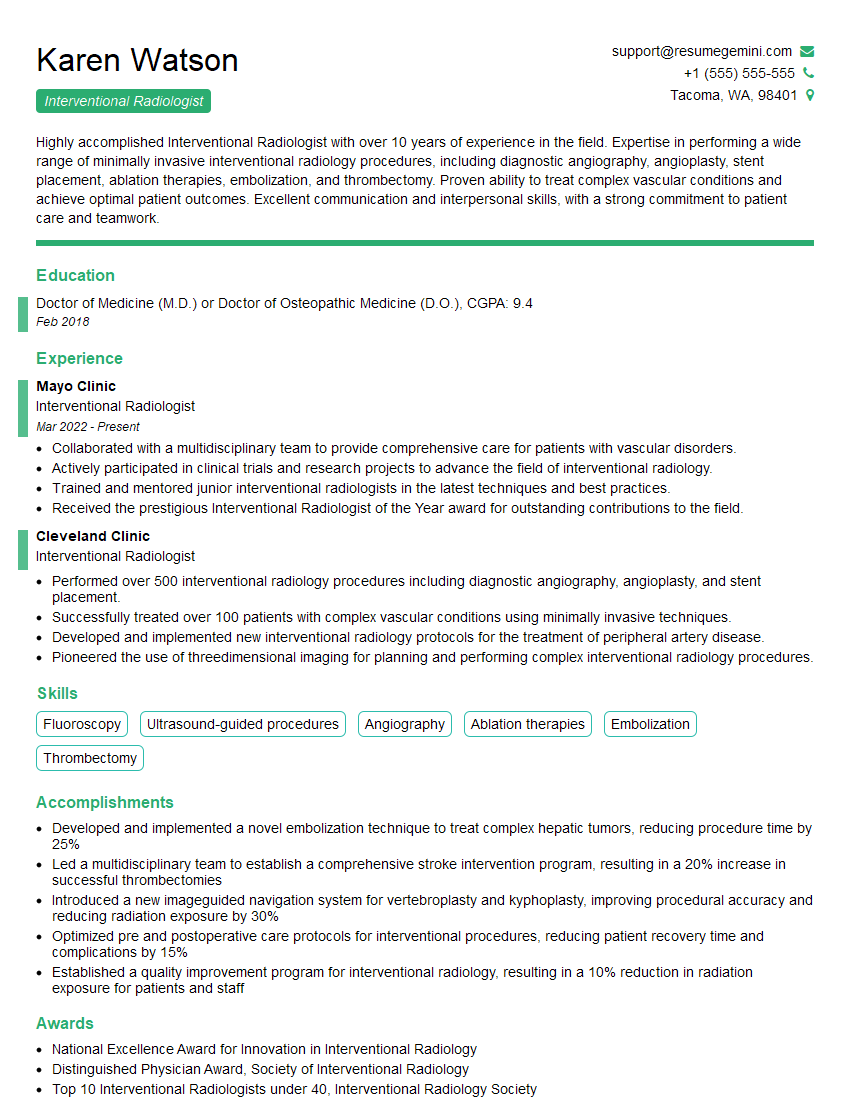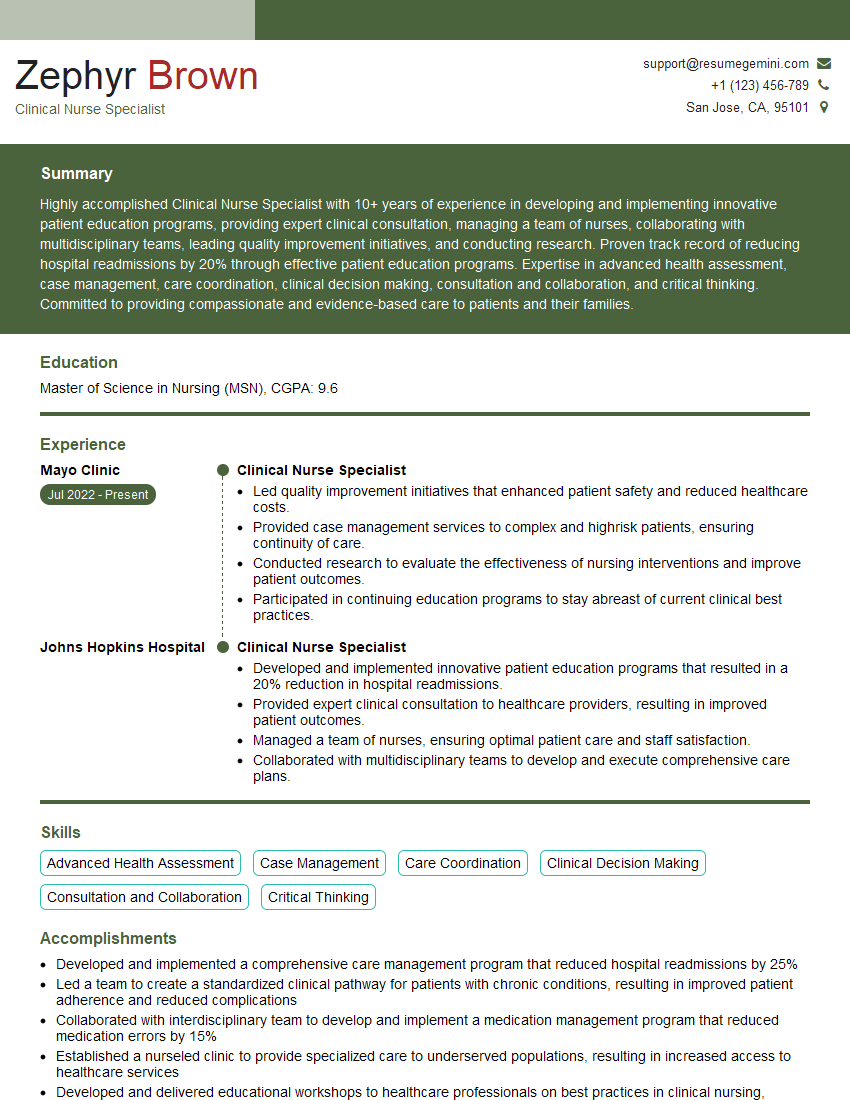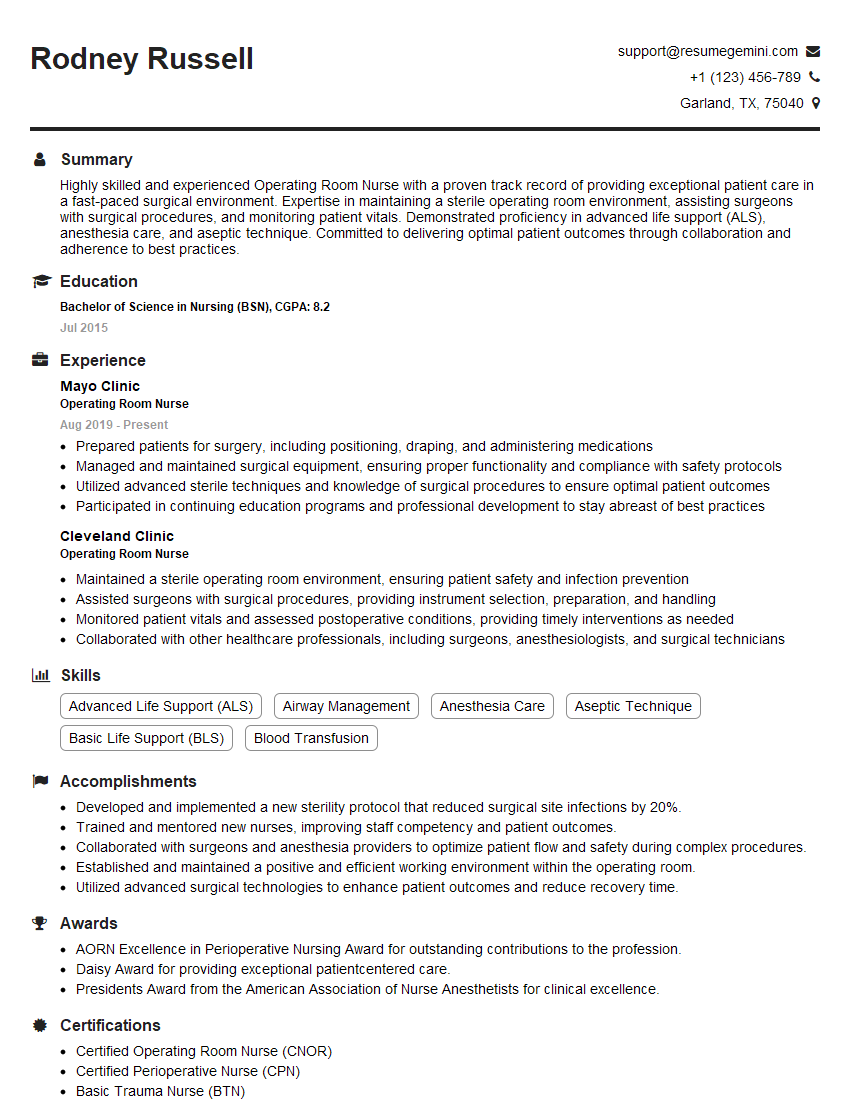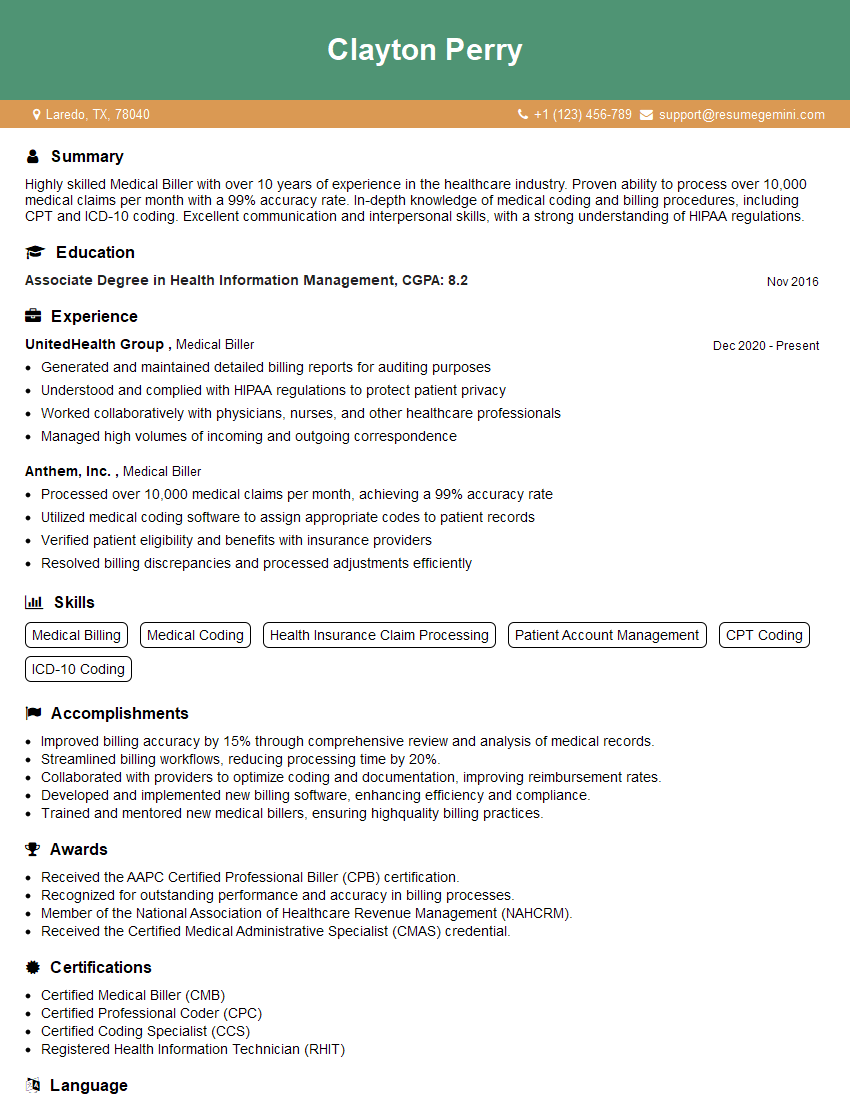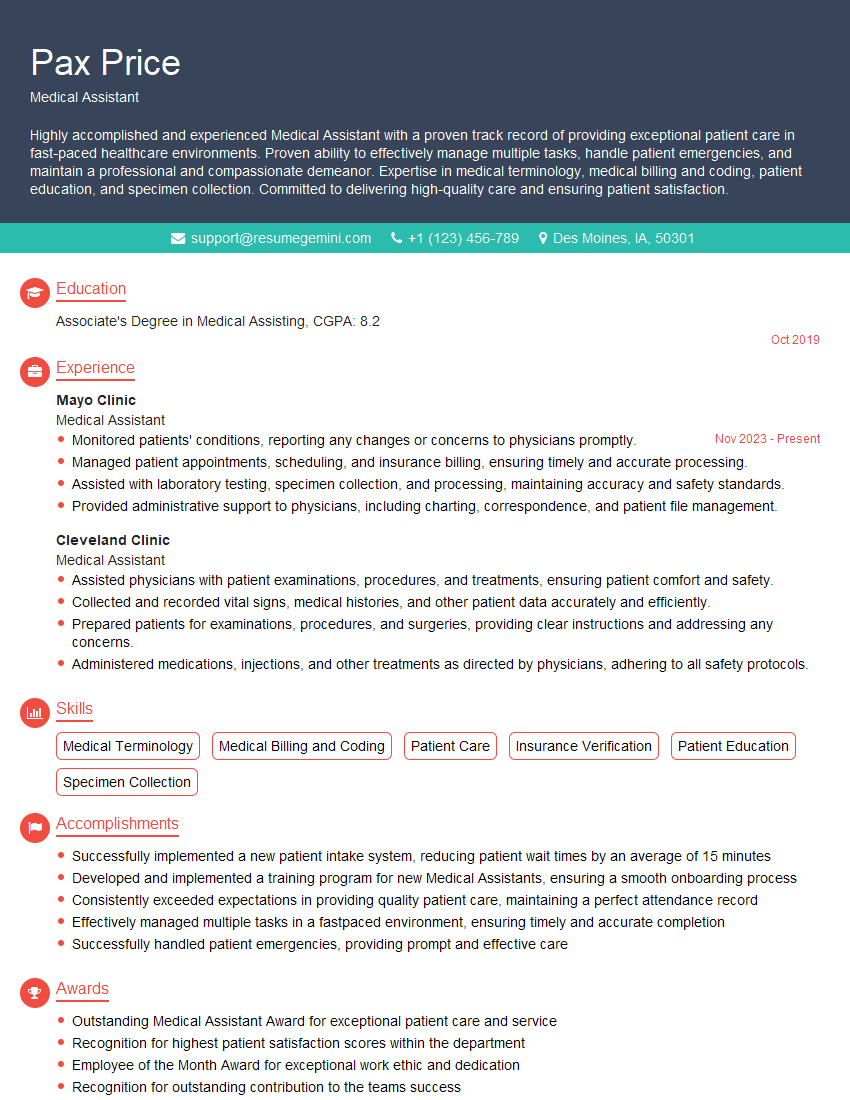The thought of an interview can be nerve-wracking, but the right preparation can make all the difference. Explore this comprehensive guide to Uterine and Cervical Ablation interview questions and gain the confidence you need to showcase your abilities and secure the role.
Questions Asked in Uterine and Cervical Ablation Interview
Q 1. Describe the different types of uterine ablation techniques.
Uterine ablation, also known as endometrial ablation, encompasses several techniques aimed at destroying or removing the endometrium, the lining of the uterus. The goal is to reduce or eliminate heavy menstrual bleeding (menorrhagia). Different techniques utilize various energy sources to achieve this. Here are some common types:
- Rollerball ablation: Uses a heated rollerball to destroy the endometrium.
- Microwave ablation: Employs microwave energy to heat and destroy the endometrial tissue.
- Radiofrequency ablation: Uses radiofrequency energy to generate heat and ablate the endometrium. This can involve various devices like the NovaSure system.
- Laser ablation: Uses laser energy to vaporize or remove the endometrial lining.
- Hydrothermal ablation: Uses heated fluid to ablate the endometrium. A common example is the HydroThermAblator.
The choice of technique depends on factors like the patient’s anatomy, the severity of bleeding, and the physician’s experience and preference.
Q 2. What are the indications and contraindications for uterine ablation?
Uterine ablation is indicated primarily for women with heavy menstrual bleeding (menorrhagia) that significantly impacts their quality of life and hasn’t responded to medical management. It’s a good option for women who are finished having children and understand the procedure’s implications for future fertility.
Contraindications include:
- Active uterine infection: Infection needs to be treated before ablation.
- Uterine abnormalities: Conditions like fibroids or polyps may require alternative treatments.
- Desire for future pregnancy: Ablation renders the uterus unsuitable for pregnancy.
- Untreated endometrial hyperplasia or cancer: These conditions need to be addressed before considering ablation.
- Active pelvic inflammatory disease (PID): This necessitates treatment before ablation.
A thorough evaluation, including a hysteroscopy, is crucial to rule out contraindications and assess suitability for the procedure.
Q 3. Explain the procedure for a rollerball ablation.
Rollerball ablation involves inserting a hysteroscope (a thin, lighted tube) into the uterus. The hysteroscope allows visualization of the uterine cavity. A heated rollerball, attached to the hysteroscope, is then rotated across the endometrial surface. The heat generated destroys the endometrial lining. The procedure typically takes between 5 and 10 minutes.
Step-by-step:
- Preparation: The patient is given anesthesia (general or local).
- Hysteroscopy: A hysteroscope is inserted into the uterus to visualize the cavity and rule out any abnormalities.
- Ablation: The heated rollerball is systematically passed over the endometrial lining, destroying the tissue. The temperature is carefully monitored and controlled.
- Completion: Once the entire endometrial surface is treated, the rollerball is removed, and the hysteroscope is withdrawn.
- Recovery: The patient remains under observation for a short time before being discharged.
Post-procedure, patients experience some cramping and bleeding, typically resolving within a few days to weeks. Follow-up appointments are scheduled to monitor healing and assess the effectiveness of the procedure.
Q 4. What are the risks and complications associated with endometrial ablation?
While generally safe, endometrial ablation carries potential risks and complications. These can include:
- Pain: Cramping and discomfort are common immediately after the procedure, often manageable with medication.
- Bleeding: Some bleeding or spotting may occur for a few weeks after the procedure, though this usually subsides.
- Infection: Infection is a rare but serious complication and is managed with antibiotics.
- Fluid overload: This is rare, and usually related to the fluid used during the procedure. Strict monitoring is crucial to prevent this.
- Uterine perforation: Accidental puncture of the uterine wall is a rare but serious complication. This is usually avoidable through careful technique and visualization.
- Incomplete ablation: This can lead to persistent or recurring heavy bleeding, potentially requiring a repeat procedure.
- Scarring and adhesions: Formation of scar tissue can sometimes lead to problems.
The incidence of these complications varies depending on the ablation technique and the operator’s skill and experience.
Q 5. How do you counsel patients about the risks and benefits of uterine ablation?
Patient counseling is crucial before undertaking uterine ablation. It’s a shared decision-making process, ensuring the patient fully understands the procedure’s implications.
The conversation should cover:
- Benefits: Reduction or elimination of heavy menstrual bleeding, improved quality of life.
- Risks: Detailed explanation of the potential complications listed above, emphasizing their rarity and management strategies.
- Alternatives: Discussion of alternative treatments such as medication, hormonal therapies, and hysterectomy.
- Success rates: Realistic expectations regarding the procedure’s effectiveness, acknowledging that it’s not always 100% successful.
- Post-procedure care: Explanation of recovery expectations, pain management, and follow-up appointments.
- Irreversible infertility: Emphasize that uterine ablation makes future pregnancies impossible.
Providing written materials and encouraging questions are essential components of comprehensive counseling.
Q 6. What is the role of hysteroscopy in uterine ablation procedures?
Hysteroscopy plays a vital role in uterine ablation procedures. It’s used for preoperative assessment and during the procedure itself.
Preoperative assessment: Hysteroscopy allows visualization of the uterine cavity to identify any abnormalities like polyps, fibroids, or structural defects that could contraindicate ablation or modify the procedural approach. This helps to avoid unexpected issues during the procedure.
Intraoperative role: During the procedure, hysteroscopy provides real-time visualization, enabling the physician to accurately target the endometrial lining for ablation and ensure complete treatment. It also helps to prevent accidental perforation of the uterine wall.
Essentially, hysteroscopy transforms the procedure from a ‘blind’ to a ‘sighted’ operation and increases both safety and efficacy.
Q 7. Compare and contrast different types of energy sources used in ablation (e.g., radiofrequency, microwave, laser).
Several energy sources are used in endometrial ablation, each with its advantages and disadvantages:
- Radiofrequency (RF): Generates heat through electrical resistance within the tissue. It’s relatively easy to use, produces less smoke than laser, and can be effective. The NovaSure system is a common example.
- Microwave: Uses microwave energy to heat and destroy endometrial tissue. It’s a relatively quick procedure and also creates less smoke than laser ablation.
- Laser: Uses highly focused light energy to vaporize or ablate the endometrium. It provides precise targeting but can generate smoke, requiring specialized smoke evacuation systems.
Comparison:
| Feature | Radiofrequency | Microwave | Laser |
|---|---|---|---|
| Precision | Moderate | Moderate | High |
| Speed | Moderate | Fast | Moderate |
| Smoke production | Low | Low | High |
| Cost | Moderate | Moderate | High |
The choice of energy source is often based on the physician’s experience, the availability of equipment, and the specific clinical circumstances. No single energy source is universally superior; the best approach depends on several factors.
Q 8. Discuss the postoperative management of patients undergoing uterine ablation.
Postoperative management after uterine ablation focuses on minimizing discomfort and detecting potential complications. It’s crucial to remember that the specific post-operative care will vary depending on the type of ablation performed (e.g., thermal balloon ablation, rollerball ablation, microwave ablation).
Immediate Post-op: Patients typically experience some cramping and bleeding, often managed with over-the-counter pain relievers like ibuprofen and rest. We advise patients to avoid strenuous activity for several weeks. We provide specific instructions regarding hygiene, including avoiding tampons and douching for a specified period (usually 4-6 weeks) to prevent infection.
Follow-up Appointments: Regular follow-up appointments are scheduled to monitor for complications like infection, excessive bleeding, or incomplete ablation. These appointments may include physical exams and sometimes ultrasound scans to assess the uterine cavity.
Long-term Monitoring: While most patients experience relief from heavy menstrual bleeding, some may have persistent spotting or irregular bleeding. It’s important to address these concerns during follow-up visits. We emphasize the importance of reporting any concerning symptoms, such as fever, severe abdominal pain, or heavy, prolonged bleeding.
Patient Education: Thorough patient education is crucial. We provide written instructions, answer questions extensively, and ensure patients understand what to expect in the recovery phase, when to seek medical attention, and what constitutes normal versus abnormal post-operative experience.
Q 9. How do you manage potential complications such as perforation or hemorrhage during ablation?
Managing complications during uterine or cervical ablation requires immediate action and often involves a multidisciplinary approach.
Perforation: Uterine perforation, while rare, is a serious complication. Immediate management involves ceasing the procedure, assessing the patient’s hemodynamic status, and providing intravenous fluids if necessary. Depending on the severity and location of the perforation, laparoscopic or open surgery may be required to repair the damage. Close monitoring for signs of infection and intra-abdominal bleeding is essential.
Hemorrhage: Excessive bleeding can occur during ablation. Immediate steps include stopping the procedure, carefully evaluating the source of bleeding, and using techniques to control bleeding, which may include uterine packing or other haemostatic methods. If bleeding is uncontrolled, immediate transfer to the operating room for surgical intervention might be necessary. Blood transfusions may be required to stabilize the patient.
Prevention: Careful patient selection, meticulous technique during the procedure, and use of appropriate imaging technology (e.g., ultrasound) significantly minimize the risk of these complications. Regular training and adherence to standardized protocols are also critical for minimizing the risk of these serious events.
Q 10. Describe the different types of cervical ablation techniques.
Cervical ablation techniques aim to destroy or remove abnormal cervical tissue, often addressing conditions like chronic cervicitis or cervical intraepithelial neoplasia (CIN). Several methods exist:
- Cryotherapy: This involves freezing the abnormal tissue using liquid nitrogen.
- Laser Ablation: Different laser types (e.g., CO2 laser) can precisely vaporize or remove abnormal tissue.
- Electrocautery: Electrical energy is used to destroy the abnormal tissue.
- Radiofrequency Ablation: Radiofrequency energy generates heat to destroy the target tissue.
- LEEP (Loop Electrosurgical Excision Procedure): A thin wire loop with electrical current is used to excise the affected tissue. This is more excisional than ablative.
The choice of technique depends on various factors, including the extent and location of the lesion, patient characteristics, and the physician’s expertise.
Q 11. What are the indications and contraindications for cervical ablation?
Indications for Cervical Ablation: Cervical ablation is primarily indicated for treating persistent, abnormal cervical bleeding or lesions causing problems. Specific indications include chronic cervicitis (inflammation of the cervix), cervical intraepithelial neoplasia (CIN) (precancerous changes), and some cases of ectropion (eversion of the cervical lining).
Contraindications: Several factors contraindicate cervical ablation. These include:
- Pregnancy: Ablation should not be performed during pregnancy.
- Active pelvic inflammatory disease (PID): Infection can worsen post-operatively.
- Cervical cancer: Ablation is not appropriate for treating cervical cancer.
- Untreated cervical infection: Infections must be treated before ablation.
- Unexplained vaginal bleeding: The cause of the bleeding needs to be fully investigated before ablation.
- Significant cervical stenosis: Narrowing of the cervix can make the procedure difficult.
A thorough evaluation, including a colposcopy and biopsy if indicated, is necessary to determine suitability for cervical ablation.
Q 12. Explain the procedure for a cryotherapy ablation of the cervix.
Cryotherapy ablation of the cervix is a minimally invasive procedure that uses extreme cold to destroy abnormal tissue.
Procedure Steps:
- Preparation: The cervix is cleansed and prepared. A speculum is inserted to visualize the cervix.
- Cryoprobe Application: A cryoprobe (a device that delivers liquid nitrogen) is applied to the abnormal cervical tissue. The exact placement and freeze cycles are determined by the size and location of the lesion.
- Freezing Cycles: The cryoprobe freezes the tissue, typically in several cycles, each lasting a few minutes. The aim is to achieve complete destruction of the abnormal cells.
- Thawing: Between freezing cycles, the tissue is allowed to thaw.
- Post-Procedure: After the procedure, a brief period of observation ensures no immediate complications. Patients typically receive post-operative instructions regarding pain management, hygiene, and follow-up appointments.
Monitoring for complications such as infection or excessive bleeding is done during the immediate post-procedure period and at subsequent follow-up appointments.
Q 13. What are the risks and complications associated with cervical ablation?
While generally safe, cervical ablation carries potential risks and complications:
- Infection: Infection is a possibility, especially if proper aseptic technique isn’t followed.
- Bleeding: Excessive bleeding can occur during or after the procedure.
- Cervical stenosis (narrowing): This can make future procedures like Pap smears more difficult.
- Pain: Some patients experience discomfort, usually manageable with analgesics.
- Incomplete ablation: The procedure may not completely remove the abnormal tissue, requiring additional treatment.
- Scarring: Scarring can occur at the treatment site.
- Incompetent cervix (in rare cases): Weakening of the cervix, potentially leading to pregnancy complications.
The specific risks vary depending on the technique used and the patient’s overall health. It’s crucial to have a comprehensive discussion with the patient about these potential risks before proceeding with the ablation.
Q 14. How do you monitor patients post-cervical ablation for complications?
Post-cervical ablation monitoring is essential to identify and manage potential complications.
Immediate Post-op: Patients are observed for signs of excessive bleeding, pain, or infection immediately after the procedure. Vital signs are closely monitored.
Follow-up Appointments: Regular follow-up appointments are scheduled to assess healing, check for infection, and evaluate the effectiveness of the ablation. These appointments often involve a pelvic examination.
Symptom Monitoring: Patients are instructed to report any unusual symptoms, such as increased vaginal bleeding, fever, severe abdominal pain, foul-smelling discharge, or persistent pain, immediately.
Imaging (If indicated): Depending on the specific concerns, imaging studies like ultrasound may be used to assess the cervix and rule out complications.
The importance of patient communication and follow-up cannot be overstated. Thorough patient education and close monitoring are vital for minimizing the risks and ensuring the best possible outcomes after cervical ablation. This includes providing contact information and encouraging them to reach out if they have any questions or concerns.
Q 15. What is the long-term success rate of uterine and cervical ablation?
The long-term success rate of uterine and cervical ablation for managing heavy menstrual bleeding varies depending on the technique used, patient characteristics, and definition of success. Generally, studies show a high initial success rate, often exceeding 80%, with significant reduction or cessation of menstrual bleeding. However, this success rate can decline over time. For uterine ablation, long-term success (defined as amenorrhea or significant bleeding reduction) might be around 70-80% at 5 years, and slightly lower beyond that. Factors affecting long-term success include the patient’s age, the severity of pre-ablation bleeding, the type of ablation procedure performed, and the presence of underlying uterine pathologies. It’s crucial to manage patient expectations by clearly outlining that while ablation is highly effective for many, some women may still experience breakthrough bleeding or require additional interventions in the long run.
Career Expert Tips:
- Ace those interviews! Prepare effectively by reviewing the Top 50 Most Common Interview Questions on ResumeGemini.
- Navigate your job search with confidence! Explore a wide range of Career Tips on ResumeGemini. Learn about common challenges and recommendations to overcome them.
- Craft the perfect resume! Master the Art of Resume Writing with ResumeGemini’s guide. Showcase your unique qualifications and achievements effectively.
- Don’t miss out on holiday savings! Build your dream resume with ResumeGemini’s ATS optimized templates.
Q 16. How do you differentiate between appropriate candidates for uterine vs. cervical ablation?
Choosing between uterine and cervical ablation hinges entirely on the source of the bleeding. Uterine ablation targets the uterine lining (endometrium), effectively reducing or eliminating menstrual bleeding. It’s the preferred choice when heavy bleeding originates from the endometrium itself, such as in cases of menorrhagia (heavy periods) due to fibroids, adenomyosis, or other endometrial conditions. Cervical ablation, on the other hand, focuses on the cervix and is considered when the bleeding is primarily originating from cervical pathology, like cervical ectropion (eversion of the cervical lining) or other cervical lesions. A thorough history, pelvic exam, and often, diagnostic tests like hysteroscopy and sonohysterography are crucial to pinpointing the precise source and selecting the appropriate ablation method. For example, a patient with heavy periods and an enlarged uterus on ultrasound might be a good candidate for uterine ablation, while a patient with post-coital bleeding and a visibly abnormal cervix would be better suited to cervical ablation.
Q 17. Discuss the role of imaging (e.g., ultrasound, MRI) in the pre- and post-ablation assessment.
Imaging plays a critical role in both pre- and post-ablation assessment. Pre-ablation, transvaginal ultrasound (TVUS) is commonly used to evaluate uterine size, shape, and the presence of fibroids, polyps, or other structural abnormalities. Sonohysterography (SHG), which involves injecting saline into the uterine cavity, can offer a better visualization of the endometrial cavity. MRI may be utilized in more complex cases to further assess the endometrial lining and identify underlying conditions like adenomyosis. Post-ablation, TVUS can help confirm the procedural success, assess for complications (e.g., uterine perforation), and identify any residual endometrial tissue. Follow-up imaging is guided by clinical findings and is not routinely required in all patients. A patient presenting with persistent heavy bleeding post-ablation would warrant additional imaging to rule out retained endometrial tissue or other causes.
Q 18. Explain the difference between thermal and non-thermal ablation methods.
Thermal ablation methods use heat to destroy the endometrial lining or cervical tissue. Examples include rollerball ablation, microwave ablation, and radiofrequency ablation. These methods achieve tissue destruction by raising the temperature to a level that causes cellular death. Non-thermal methods, on the other hand, employ other mechanisms to destroy the tissue. Novasure, for instance, uses monopolar electrical energy to ablate the endometrium via electrical desiccation, without using heat in the traditional sense. The choice between thermal and non-thermal techniques depends on several factors, including the patient’s anatomy, the physician’s experience, and the available resources. Each has its own advantages and disadvantages concerning procedural time, potential complications, and patient comfort.
Q 19. What are the patient selection criteria for each ablation technique?
Patient selection criteria vary slightly depending on the specific ablation technique but generally include: a desire to avoid further pregnancies; a thorough understanding of the procedure and its risks; absence of active pelvic infection; a normal coagulation profile; normal uterine anatomy (though some techniques can accommodate minor abnormalities); and the absence of significant uterine pathology that could contraindicate the procedure. Women with severe anemia, uncontrolled medical conditions, or those who may require future pregnancy should not be candidates for ablation. For example, a patient with severe fibroids might be better served with a hysterectomy, while a patient with a history of pelvic inflammatory disease might require treatment before considering ablation.
Q 20. How do you manage patient expectations regarding the success and potential limitations of ablation?
Managing patient expectations is paramount. I always begin by clearly explaining the procedure, its potential benefits (reduction or cessation of heavy bleeding), and its potential limitations (e.g., possibility of breakthrough bleeding, need for further interventions, and potential long-term complications such as scarring, perforation, or infection). I discuss realistic success rates, emphasizing that individual results may vary. I encourage open communication and address any concerns or anxieties the patient may have. Using patient education materials and providing contact information for post-operative support further helps to set and manage realistic expectations. For instance, I’ll often share stories of previous patients with similar conditions and their outcomes, remembering to maintain patient confidentiality.
Q 21. Describe your experience with different types of ablation equipment.
My experience encompasses various ablation techniques and equipment. I’ve used rollerball ablation systems extensively, appreciating their versatility and effectiveness for treating various endometrial conditions. I’ve also employed microwave and radiofrequency ablation systems, recognizing the benefits of these minimally invasive approaches. My experience with Novasure ablation has highlighted its ease of use and relatively short procedural time. Selection of the appropriate equipment depends on factors such as the patient’s uterine anatomy, the presence of any uterine pathology, and the preference of the physician. I always stay updated on the latest advancements in ablation technology and techniques to ensure I offer my patients the best and most suitable options.
Q 22. What are the common causes of failure in uterine ablation procedures?
Uterine ablation failures, while relatively uncommon with modern techniques, can stem from several sources. Incomplete ablation is a major factor; this means that not all of the endometrial lining has been effectively destroyed, leading to persistent or recurring bleeding. This can happen due to variations in endometrial thickness, the presence of fibroids (benign tumors) interfering with treatment, or technical challenges during the procedure itself. Another cause is inadequate assessment of the patient’s suitability for the procedure. For example, patients with certain underlying medical conditions or specific uterine anatomical features might not be ideal candidates, leading to a higher chance of failure. Finally, the type of ablation technique used plays a crucial role. Some methods are inherently less effective than others, and operator skill significantly impacts the outcome. For instance, a less experienced physician might not achieve optimal tissue destruction, increasing the likelihood of failure. Regular post-procedure follow-up is vital to assess effectiveness and address potential complications early on.
Q 23. How do you address patient concerns and anxieties regarding the procedure?
Addressing patient anxieties is paramount. I begin by creating a safe and comfortable environment where patients feel empowered to voice their concerns. I start with a comprehensive explanation of the procedure in simple, non-medical terms, using analogies they can understand. For instance, I might compare the ablation to removing weeds from a garden to prevent unwanted growth. I carefully answer all questions honestly and openly, emphasizing the benefits while acknowledging potential risks and side effects. I provide realistic expectations about the procedure’s success rate and recovery time, acknowledging that individual responses vary. I also encourage patients to bring a support person to their consultations. This approach helps alleviate fears and promotes informed decision-making. Finally, I always offer access to additional resources, like patient support groups or brochures, to facilitate informed decision-making.
Q 24. Describe your approach to informed consent for uterine and cervical ablation.
Informed consent for uterine and cervical ablation is a multi-step process that involves a thorough discussion about the procedure’s purpose, benefits, risks, and alternatives. I explain the procedure’s mechanism, highlighting that it aims to reduce or eliminate menstrual bleeding. We discuss potential complications, including those mentioned previously, and less frequent ones like perforation (a hole in the uterus) or infection. I meticulously explain the recovery process and the likelihood of success. Crucially, I present alternative treatment options, such as medication or hysterectomy (surgical removal of the uterus), allowing patients to compare and choose what aligns best with their health and life goals. The entire discussion is documented, with the patient’s understanding verified through questions and answers. I ensure the patient understands they have the right to refuse the procedure at any stage and that their decision is respected, without any pressure. This ensures a truly informed consent that aligns with ethical and legal standards.
Q 25. How do you ensure patient safety during and after the ablation procedure?
Patient safety is my top priority throughout the process. Before the procedure, a comprehensive evaluation assesses the patient’s overall health and suitability for the ablation. This involves reviewing their medical history, conducting physical examinations, and potentially ordering specific tests. During the procedure, I follow strict sterile techniques to minimize the risk of infection. Monitoring vital signs closely throughout the procedure is crucial. Modern ablation techniques frequently employ minimally invasive approaches, such as using a hysteroscope (a thin, lighted tube inserted into the uterus), reducing the risks associated with more extensive surgeries. Post-procedure, careful monitoring for complications like bleeding, infection, or pain is implemented. Providing patients with clear instructions regarding pain management, activity restrictions, and potential signs of complications, accompanied by scheduled follow-up appointments, further contributes to enhanced safety.
Q 26. How do you handle adverse events or unexpected complications during the procedure?
Handling adverse events requires prompt action and a calm, decisive approach. If a complication arises during the procedure, I immediately prioritize the patient’s safety and well-being. This might involve stopping the procedure, initiating appropriate treatment for the complication (such as managing bleeding or infection), and contacting the appropriate specialists, if needed. Depending on the severity of the complication, hospitalization might be necessary. Throughout the process, I maintain open communication with the patient and their family, providing honest updates about their condition and the steps being taken. After the event, a thorough review of the case is conducted to determine the cause of the complication and identify any areas for improvement in our protocols or techniques. This learning process is essential in preventing similar events in the future. Transparent documentation of the event is crucial for medical records and potential legal considerations.
Q 27. What are the latest advancements and research findings in uterine and cervical ablation techniques?
The field of uterine and cervical ablation is constantly evolving. Recent advancements include the development of more refined energy sources for ablation, leading to improved precision and reduced complications. For example, improvements in radiofrequency ablation systems offer better control over tissue destruction. Minimally invasive techniques, like those utilizing smaller instruments and less tissue disruption, are becoming increasingly prevalent. Research is focusing on techniques to better predict which patients are most likely to benefit from these procedures, potentially reducing the incidence of failure. Studies are also exploring new energy modalities and exploring ways to personalize ablation approaches, tailoring the procedure to the specific characteristics of each patient’s uterus and endometrial tissue. This personalized approach, combined with advances in imaging techniques, is paving the way for improved success rates and patient outcomes.
Q 28. How do you stay updated with the latest guidelines and recommendations in the field?
Staying updated is crucial in a field with rapidly advancing knowledge. I actively participate in professional organizations such as the American College of Obstetricians and Gynecologists (ACOG), attending conferences, workshops, and continuing medical education courses. I regularly review peer-reviewed medical journals and publications, specifically focusing on publications related to ablation techniques, advancements, and best practice guidelines. Membership in professional societies provides access to the latest guidelines and recommendations, often directly informing my practice. Moreover, I participate in interdisciplinary discussions with colleagues specializing in related fields to share knowledge and insights. This multi-faceted approach ensures I remain at the forefront of best practices and provide the most advanced, safest, and effective care to my patients.
Key Topics to Learn for Uterine and Cervical Ablation Interview
- Types of Ablation Procedures: Understand the differences between various uterine and cervical ablation techniques (e.g., endometrial ablation, rollerball ablation, cryotherapy), including their indications, contraindications, and procedural steps.
- Patient Selection and Preoperative Assessment: Master the criteria for selecting appropriate candidates for ablation, including evaluating medical history, conducting physical examinations, and interpreting relevant diagnostic tests.
- Postoperative Care and Management: Familiarize yourself with best practices for post-operative care, including pain management, monitoring for complications, and providing patient education.
- Complications and Management: Thoroughly understand potential complications associated with uterine and cervical ablation procedures and develop strategies for their prevention and management.
- Technological Advancements: Stay updated on the latest advancements in ablation techniques, instrumentation, and energy sources, and their impact on patient outcomes.
- Ethical Considerations: Be prepared to discuss ethical considerations surrounding ablation procedures, particularly informed consent and shared decision-making with patients.
- Comparative Analysis of Techniques: Be able to compare and contrast different ablation techniques based on efficacy, safety, and cost-effectiveness.
- Long-Term Outcomes and Follow-up: Understand the long-term implications of ablation, including potential for recurrence of bleeding and impact on future fertility.
Next Steps
Mastering Uterine and Cervical Ablation procedures significantly enhances your value as a skilled healthcare professional, opening doors to diverse and rewarding career opportunities. To maximize your job prospects, it’s crucial to present your expertise effectively. Crafting an ATS-friendly resume is key to getting your application noticed by recruiters. We highly recommend using ResumeGemini to build a professional and impactful resume that highlights your unique skills and experience in this specialized field. ResumeGemini offers examples of resumes tailored to Uterine and Cervical Ablation to help guide you in creating a winning application.
Explore more articles
Users Rating of Our Blogs
Share Your Experience
We value your feedback! Please rate our content and share your thoughts (optional).
What Readers Say About Our Blog
This was kind of a unique content I found around the specialized skills. Very helpful questions and good detailed answers.
Very Helpful blog, thank you Interviewgemini team.
